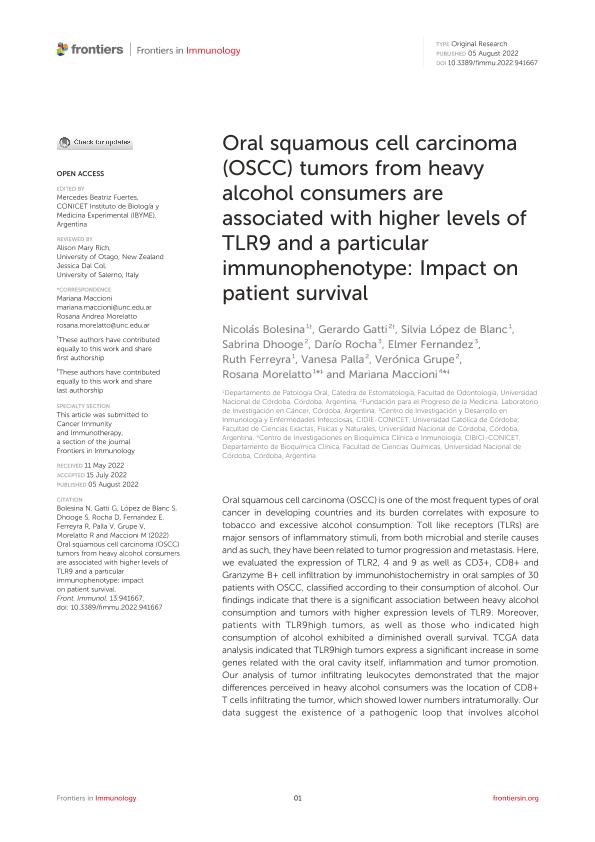Mostrar el registro sencillo del ítem
dc.contributor.author
Bolesina, Nicolás Jorge

dc.contributor.author
Gatti, Gerardo Alberto

dc.contributor.author
López de Blanc, Silvia
dc.contributor.author
Dhooge, Sabrina
dc.contributor.author
Rocha, Darío Gastón

dc.contributor.author
Fernandez, Elmer Andres

dc.contributor.author
Ferreyra, Ruth Salome

dc.contributor.author
Palla, Vanesa
dc.contributor.author
Grupe, Verónica Maria

dc.contributor.author
Morelatto, Rosana Andrea

dc.contributor.author
Maccioni, Mariana

dc.date.available
2023-11-15T15:43:20Z
dc.date.issued
2022-08
dc.identifier.citation
Bolesina, Nicolás Jorge; Gatti, Gerardo Alberto; López de Blanc, Silvia; Dhooge, Sabrina; Rocha, Darío Gastón; et al.; Oral squamous cell carcinoma (OSCC) tumors from heavy alcohol consumers are associated with higher levels of TLR9 and a particular immunophenotype: Impact on patient survival; Frontiers Media; Frontiers in Immunology; 13; 8-2022; 1-13
dc.identifier.issn
1664-3224
dc.identifier.uri
http://hdl.handle.net/11336/218194
dc.description.abstract
Oral squamous cell carcinoma (OSCC) is one of the most frequent types of oral cancer in developing countries and its burden correlates with exposure to tobacco and excessive alcohol consumption. Toll like receptors (TLRs) are major sensors of inflammatory stimuli, from both microbial and sterile causes and as such, they have been related to tumor progression and metastasis. Here, we evaluated the expression of TLR2, 4 and 9 as well as CD3+, CD8+ and Granzyme B+ cell infiltration by immunohistochemistry in oral samples of 30 patients with OSCC, classified according to their consumption of alcohol. Our findings indicate that there is a significant association between heavy alcohol consumption and tumors with higher expression levels of TLR9. Moreover, patients with TLR9high tumors, as well as those who indicated high consumption of alcohol exhibited a diminished overall survival. TCGA data analysis indicated that TLR9high tumors express a significant increase in some genes related with the oral cavity itself, inflammation and tumor promotion. Our analysis of tumor infiltrating leukocytes demonstrated that the major differences perceived in heavy alcohol consumers was the location of CD8+ T cells infiltrating the tumor, which showed lower numbers intratumorally. Our data suggest the existence of a pathogenic loop that involves alcohol consumption, high TLR9 expression and the immunophenotype, which might have a profound impact on the progression of the disease.
dc.format
application/pdf
dc.language.iso
eng
dc.publisher
Frontiers Media

dc.rights
info:eu-repo/semantics/openAccess
dc.rights.uri
https://creativecommons.org/licenses/by-nc-sa/2.5/ar/
dc.subject
ALCOHOL CONSUMPTION
dc.subject
CD8+T CELL INFILTRATION
dc.subject
IMMUNOPHENOTYPE
dc.subject
ORAL SQUAMOUS CELL CARCINOMA
dc.subject
TLR9
dc.subject.classification
Inmunología

dc.subject.classification
Medicina Básica

dc.subject.classification
CIENCIAS MÉDICAS Y DE LA SALUD

dc.title
Oral squamous cell carcinoma (OSCC) tumors from heavy alcohol consumers are associated with higher levels of TLR9 and a particular immunophenotype: Impact on patient survival
dc.type
info:eu-repo/semantics/article
dc.type
info:ar-repo/semantics/artículo
dc.type
info:eu-repo/semantics/publishedVersion
dc.date.updated
2023-11-14T14:25:51Z
dc.journal.volume
13
dc.journal.pagination
1-13
dc.journal.pais
Estados Unidos

dc.journal.ciudad
California
dc.description.fil
Fil: Bolesina, Nicolás Jorge. Universidad Nacional de Córdoba; Argentina
dc.description.fil
Fil: Gatti, Gerardo Alberto. Consejo Nacional de Investigaciones Científicas y Técnicas. Centro Científico Tecnológico Conicet - Córdoba; Argentina
dc.description.fil
Fil: López de Blanc, Silvia. Universidad Nacional de Córdoba; Argentina
dc.description.fil
Fil: Dhooge, Sabrina. Fundación Para El Progreso de la Medicina; Argentina
dc.description.fil
Fil: Rocha, Darío Gastón. Consejo Nacional de Investigaciones Científicas y Técnicas. Centro de Investigación y Desarrollo en Inmunología y Enfermedades Infecciosas. Universidad Católica de Córdoba. Centro de Investigación y Desarrollo en Inmunología y Enfermedades Infecciosas; Argentina
dc.description.fil
Fil: Fernandez, Elmer Andres. Consejo Nacional de Investigaciones Científicas y Técnicas. Centro de Investigación y Desarrollo en Inmunología y Enfermedades Infecciosas. Universidad Católica de Córdoba. Centro de Investigación y Desarrollo en Inmunología y Enfermedades Infecciosas; Argentina
dc.description.fil
Fil: Ferreyra, Ruth Salome. Universidad Nacional de Córdoba; Argentina
dc.description.fil
Fil: Palla, Vanesa. Fundación Para El Progreso de la Medicina; Argentina
dc.description.fil
Fil: Grupe, Verónica Maria. Fundación Para El Progreso de la Medicina; Argentina
dc.description.fil
Fil: Morelatto, Rosana Andrea. Universidad Nacional de Córdoba; Argentina
dc.description.fil
Fil: Maccioni, Mariana. Consejo Nacional de Investigaciones Científicas y Técnicas. Centro Científico Tecnológico Córdoba. Centro de Investigaciones en Bioquímica Clínica e Inmunología; Argentina
dc.journal.title
Frontiers in Immunology
dc.relation.alternativeid
info:eu-repo/semantics/altIdentifier/url/https://www.frontiersin.org/articles/10.3389/fimmu.2022.941667/full
dc.relation.alternativeid
info:eu-repo/semantics/altIdentifier/doi/http://dx.doi.org/10.3389/fimmu.2022.941667
Archivos asociados
